Home Safety Checklist For Long Island
Staying safe and secure in your house should be your topmost concern. But are you missing one or two big safety items? Look over this home safety checklist for Long Island and see where your living space can use some work.
This guide starts with a few whole-home safety items, and then we break it down room-by-room. Then, call (631) 213-3528 or send in the form below to talk to a security expert.
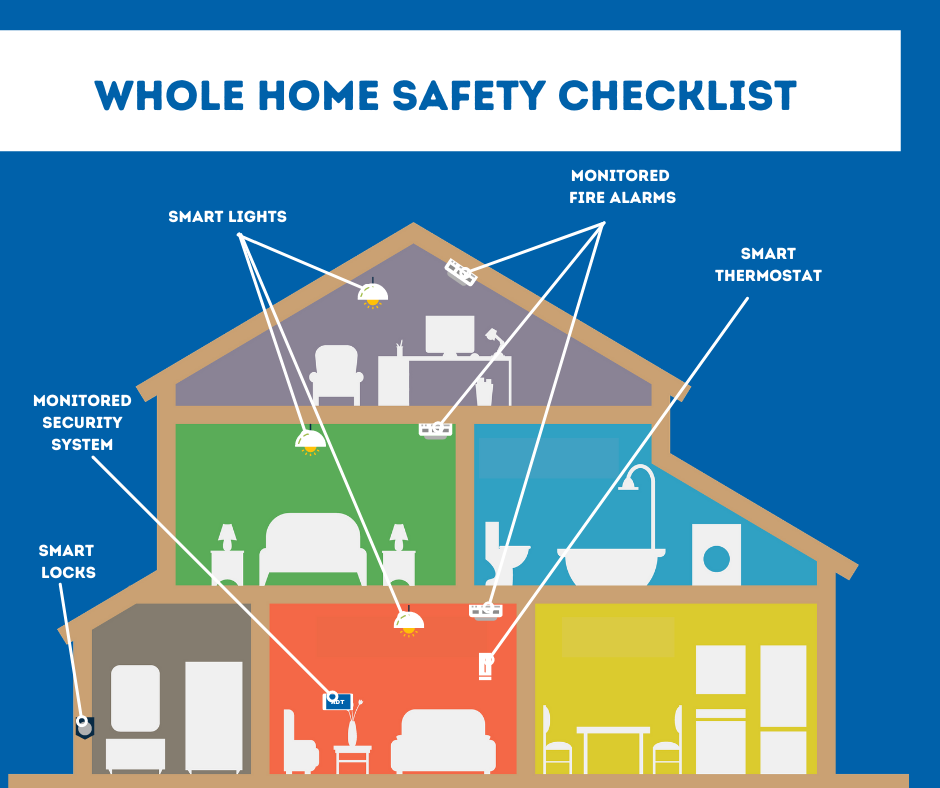
Essential Home Safety Checklist for Long Island
While you may want to use a room-to-room process for home safety in Long Island, there are a few methods that work for a lot of your rooms. These devices can talk together through a touchscreen hub, and oftentimes react to one another. You might also control every one of your home safety equipment with a smartphone app, like ADT Control:
-
Monitored Home Security System: Each one of your entryways should employ a sensor that notifies you and your family to intrusion. As your alarm trips, your monitoring team picks up the call and sends the police or fire department.
-
Smart Lighting For Every Major Room: Sure, you can program your smart lighting to become more energy-efficient. But they can also allow you to stay safe in an emergency. Make your smart bulbs flash on when a security alarm trips to shoo off burglars or brighten the way out to a outside place.
-
Smart Thermostat: Likewise, a smart thermostat in Long Island can save you between 10%-15% in utility costs. Also, it can flip on the exhaust fan when your alarms senses a fire.
-
Monitored Smoke Detectors: It’s code that you should have a smoke detector on each floor. You can improve your fire readiness by utilizing a monitored fire alarm that detects both heat and smoke, and alerts your round-the-clock monitoring agents when it detects a fire.
-
Smart Lock For Every Door: Every door that uses a deadbolt can upgrade to a smart lock. Now you can preset numbered codes to family and friends and receive alerts to your mobile device when they are activated. Your locks can even automatically unlock, helping you to quickly flee the house when you have a fire or other emergency.

Family Room/Living Room Safety Checklist For Long Island
You’ll spend a lot of time in your family room, so it’s the best area to start making your house a safer place. Highly sought after items, like a big screen or video games, probably reside in your family room, making it a tempting area for robbers. Begin with installing a motion detector or security camera in your room, then continue on with all these ideas:
-
Motion Sensors: By putting in motion detectors, you’ll have a loud alarm whenever they sense unusual movement within your family room. You’ll want motion sensors that ignore pets or you’ll have your sirens go off each time your pet passes through for a midnight stroll.
-
Indoor Camera: An indoor security camera gives you a constant watch on your living room. View constant feeds of your room so you can find out what’s happening through the mobile app. Or speak with your family in the room by using the two-way talk feature.
-
Surge Protector/Outlet Maintenance: Safeguard all your electronics and stop overtaxing your circuits with a surge protector. For added comfort, set up a smart plug with anti-surge functionality built-in.
-
Furniture Bolted To The Wall: If you have curious kids, you’ll need to attach your bookshelves and entertainment center to the wall. This is especially important if your living room uses carpeting that might make objects extra wobbly.
-
Enhanced Locks For Sliding Doors: If your living room uses a sliding door that slides out to a deck, patio, or outside porch, you probably can see that the door lock is fairly thin. Put in a custom lock, like a cross bar or small locks that are located on the bottom and top of the frame.
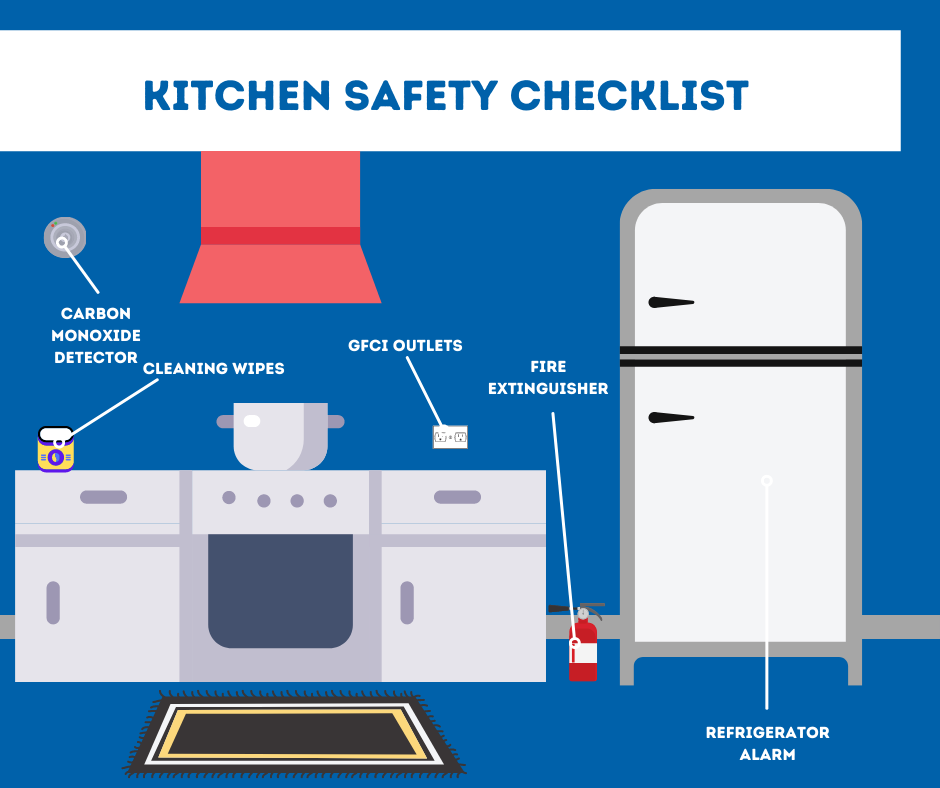
Kitchen Safety Checklist For Long Island
The kitchen has plenty of items that can provide safety and security to your house. Most of these items should be easy to add and should be bought from the grocery store:
-
Fire Extinguisher: A fire can spring up from an overfilled pot or an errant grease splatter. Always have a fire extinguisher in close reach for any kitchen emergencies.
-
GFCI Box On Every Outlet: A circuit interrupter outlet should be standard anywhere they’re by water to prevent a deadly shock. That means the outlets by your kitchen counter and sink. Since the late ‘80s, it’s been required to have one circuit interrupter outlet per dedicated circuit. But if you don’t want all your outlets to turn off when one outlet flips, you’re going to want to install a single GFCI for every outlet.
-
Monitored Carbon Monoxide Detector: A carbon monoxide detector is needed in spaces that employ gas for the oven and stove. If your gas lines leak, the carbon monoxide detector will cause a loud, buzzing noise and call your monitoring professional.
-
Cleaning Wipes Or Spray: The most overlooked safety hazard in the kitchen is the viruses, bacteria, and protein that comes with raw meat and other foods. Always have disinfectant wipes or spray to clean your area before and after making a meal.
-
Refrigerator Alarm: The food items in your fridge have to remain at a chilly temperature to be healthy to consume. If you accidently leave the refrigerator door open too long, then a constant beep will remind you to check the seal. Some appliances already have an alarm, others don’t, and you’ll have to pick up an external alarm from the hardware store.
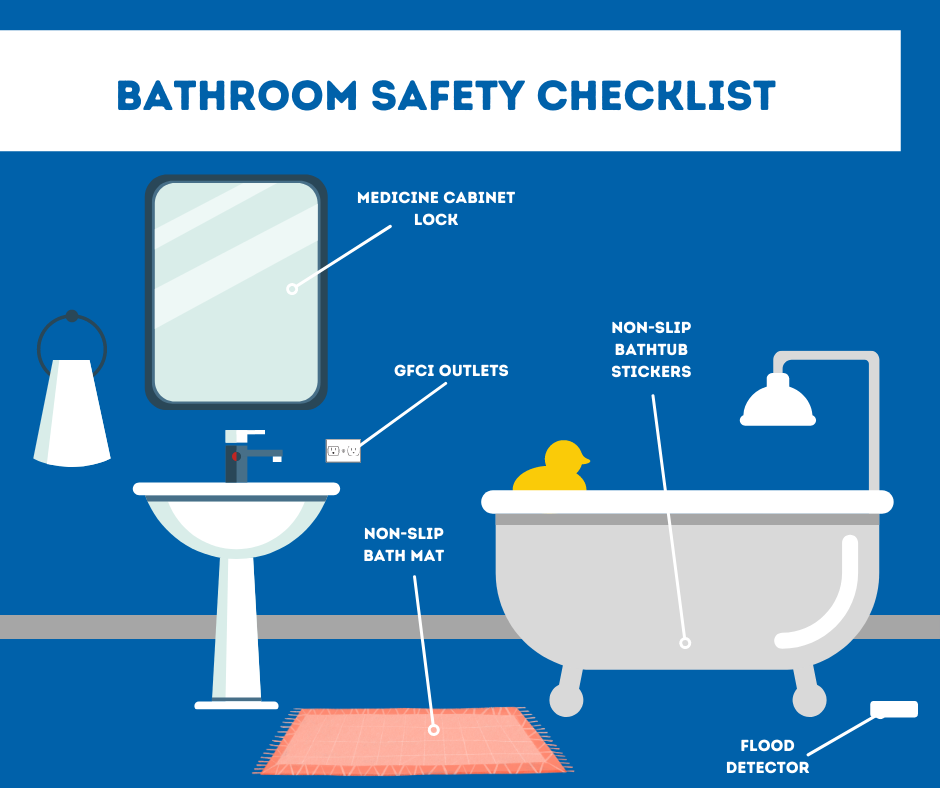
Bathroom Safety Checklist For Long Island
Just because you may not have a lot of square footage in your bathroom doesn’t mean that there aren’t safety hazards. From water problems to anti-surge outlets, here are a few safety improvements for your bathroom:
-
Flood Sensors: A leaking toilet or bathtub can cause an expensive amount of damage. Discover a leak with a flood detector and save the time and money from renovations.
-
No-slip Shower Mats: A fall in the bathroom can be devastating, causing pulled muscles, sore joints, or sprained ankles. Or steer clear from these issues with a no-slip bath mat for your wet feet.
-
Textured Bathtub Stickies: Likewise, a tub basin can be a slick area to move in. It’s a good idea that every bathtub has some textured stickers so your toes have a rough patch for stability.
-
Medicine Door Lock: If you have curious children or someone with memory difficulties, you should take additional precautions regarding prescription medicine. Secure your bottles by using a medicine cabinet with a locking latch.
-
Circuit Interrupter Outlet: Just like the kitchen, you will have to also put in a grounded circuit interrupter outlet on every bathroom outlet. These will stop the flow of the electric current if water splashes on them or you have a sudden surge from a hair dryer or curling iron.
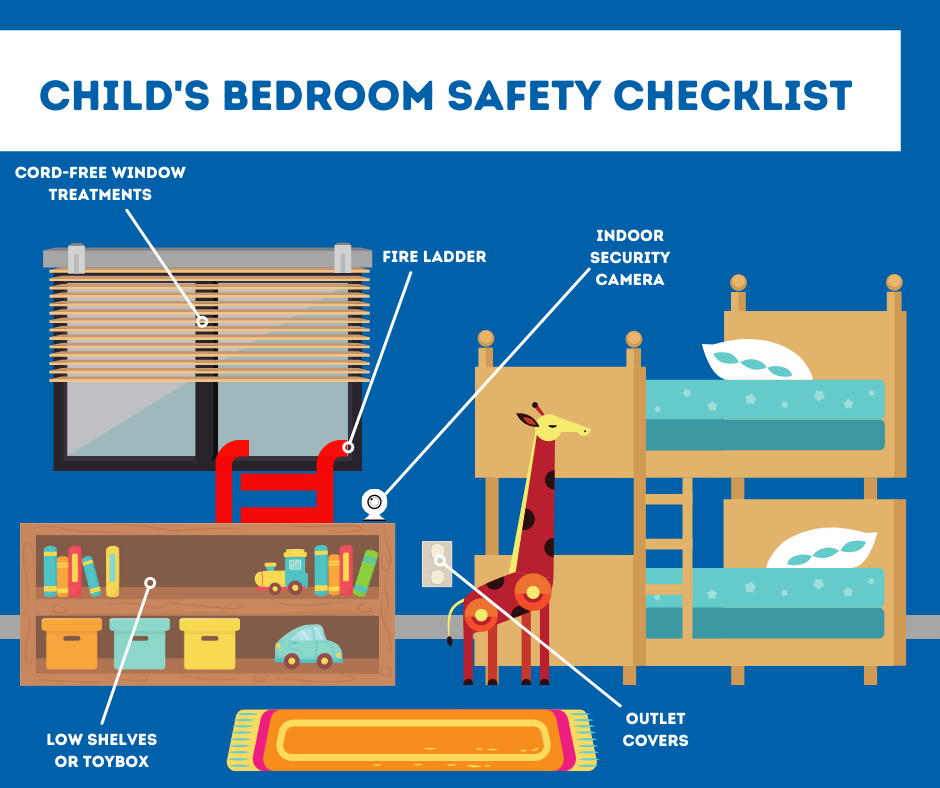
Children’s Bedroom Safety Checklist For Long Island
Your child’s bedroom should balance safety with manageability. If their window shades or other things are safe but hard to use, then your kids may try unsafe activities -- like scale a dresser -- to use them. Try these straightforward, and safe, ideas:
-
Cord-Free Window Treatments: Safety experts have long called cords from shades and blinds a hidden hazard for both children and pets. Put in motorized blinds or shades that kids can easily open and close via remote control. Or even better, pair your shades to your security system so they open without anyone’s help when it’s time to get up, and go down at bedtime for an easier sleep.
-
Indoor Security Camera: An indoor security camera perched on your toddler’s dresser can double as an HD baby monitor that you can see with your phone. And if they need something, they can use the 2-way talk button on the camera.
-
Outlet Covers: While every outlet should have protective covers on them for your small children, this is doubly needed in their bedroom. It’s the one place in your house where your child will most likely play alone without constant adult supervision.
-
Window Safety Ladder: If you use bedrooms on the second floor, then you need to have a window safety ladder. These should help your children leave the house in case the hallway or ground floor are blocked off with fire. Just remember to practice how to employ them at least twice a year.
-
Toy Chest Or Low Shelves: It’s interesting to view a toy chest as a safety item, but you’ll see the light if you’ve ever tramped on an action figure in your bare feet. A uncluttered floor gives your child a quick escape if there’s an emergency.
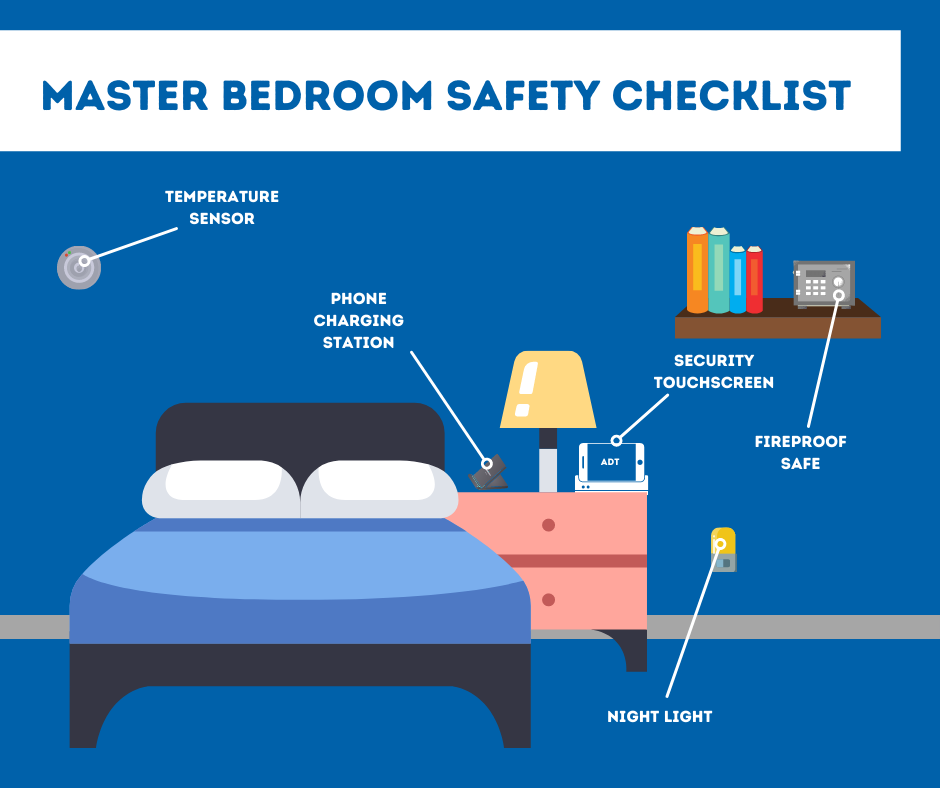
Master Bedroom Safety Checklist For Long Island
The main bedroom should be a refuge, so let your safety components give you peace of mind if you experience an emergency event. After all, being startled awake by a high-decibel alarm can be confusing.
-
Security System Touchscreen: Having a smart hub on your bedside table helps you know what’s going on without leaving your bed. You could also turn on your ADT smartphone app. However, the touchscreen is often easier to use to use when you’re coming out of sleep and finding your bearings.
-
Device Charging Station: We depend on our phones for almost everything now alarm clocks, web browsers, social media, and --legend has it-- even phones. The only problem is that a depleted phone can cut us off from the outside world if there’s a problem. To keep it nice and ready, a charging cord or station is an important part of your nightstand.
-
Smart Lights Or Nightlights: A plug-in light can be a beacon when you’re bolted awake from a fire alarm or other noises. If you can’t fall asleep with a small nightlight, install a smart bulb in your bedroom. Then you can control light on-demand with a mobile device or vocal command.
-
Fireproof Safe: Store your essential paperwork like insurance cards, stock certificates, or a spare checkbook in a fireproof safe. Your safe can be a bigger one that is located out of the way or a smaller handheld safe that you can snatch when you leave during an emergency event.
-
Temperature Sensor: The problem with most bedrooms is that they might be too warm or be cold since they are located across the house from the thermostat. A heat sensor will communicate to your smart thermostat so you can have a nice, relaxing sleep at the perfect climate.
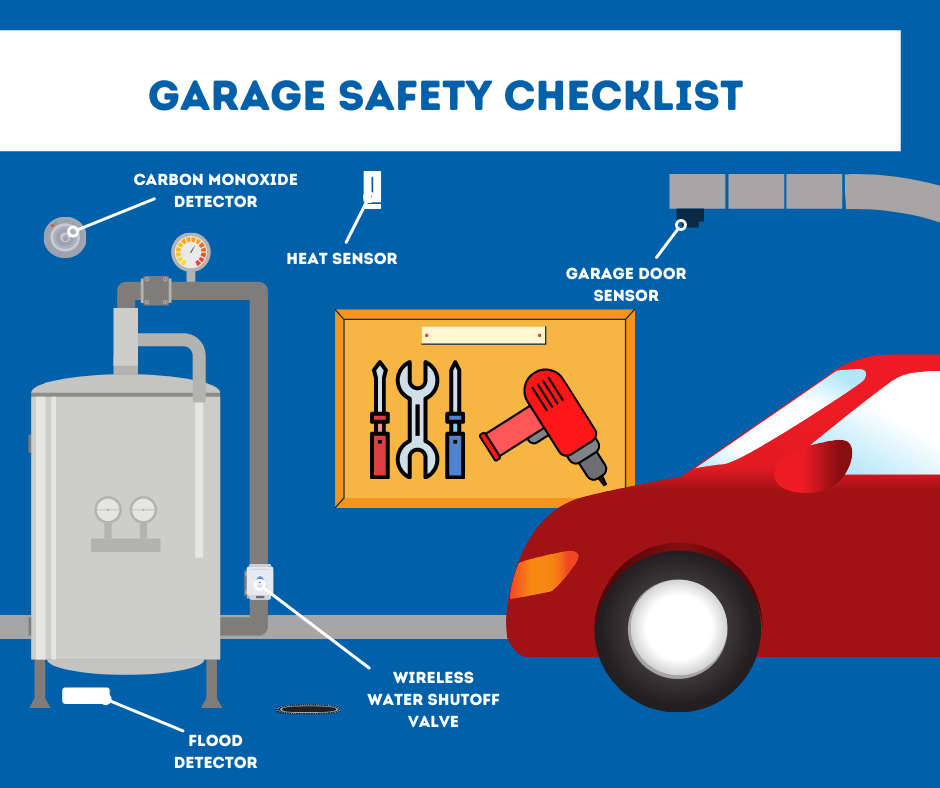
Basement/Garage Safety Checklist For Long Island
Most safety problems in the garage or basement are with your water or furnace. Discovering issues before they start can stave away larger disasters later on. So, as you look around your garage or basement, check over these crucial items:
-
Water Detector Or Sump Pump Alarm: Putting a flood sensor in back of your water heater or sump pump drain can save you from discovering a mess when you go into your garage or basement. Do you really want to waste your weekend getting rid of standing water?
-
Carbon Monoxide Detector: It’s nice to hang a CO detector in an area where a CO leak can occur. If you employ gas heat, try to put an alarm in the same place as your unit.
-
WiFi Water Shutoff Valve: If your water alarm detects a hot water heater leak or a burst pipe, then you need to shut off the primary water line at once. With a remote shutoff valve, you can stop water flow from any mobile device. That’s perfect when you’re on vacation and see a flood sensor notification on your phone.
-
Garage Door Sensor: Leaving the garage up brings about all sorts of problems. You can lose a bunch of heat or air through that large opening, and critters or intruders can just wander in. A sensor will alert you to a forgotten garage door and lets you lower it with your phone.
-
Heat Sensor: A temperature alarm in your basement or garage is a definite if you worry about your pipes freezing. The heat in these areas can be surprisingly different than the rest of the house, so you may need to have a closer eye on the temperature through your mobile app.
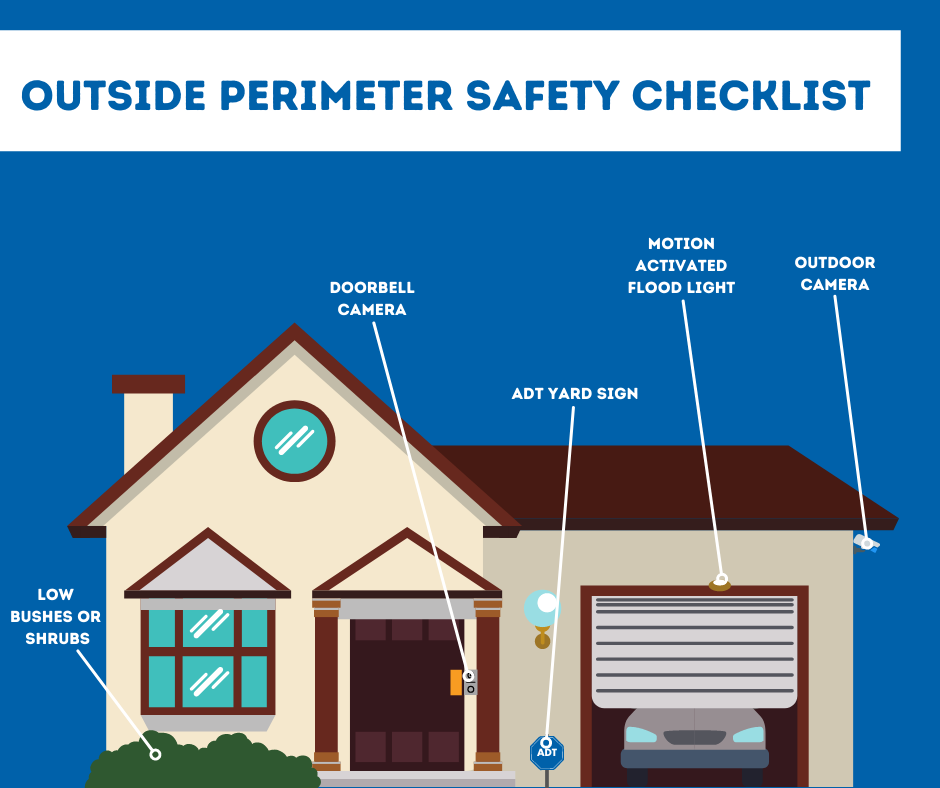
Outside Perimeter Safety Checklist for Long Island
Your yard, driveway, and front walk are just as crucial to make safe as the rest of your house. Use this checklist to make your outside safe:
-
Doorbell Camera: See who’s arrived at the the front step before you open it and chat with guests. View deliveries and record video clips if they are taken.
-
Outdoor Security Camera: You can hang outdoor security cameras to alert you to suspicious lurkers in your yard. These cameras are nice in areas where you might not have a window -- like around a cellar or by the garage.
-
Low Shrubs: High bushes can create some solitude, but they also hinder your view of the yard. Don’t provide potential intruders a place to hide. Plus, high bushes, shrubs or foliage against your house can clog gutters and summon bugs.
-
ADT Yard Signs: One of the most popular discouragements for a thief is advertising to potential rogues that you have a state-of-the-art ADT security system. An ADT sign by the main walk and a window cling will show ne'er-do-wells that they might want to move on to an easier score.
-
Motion Controlled Outside Lights: Light is the greatest enemy to those who lurk in the unlit places. Motion-triggered lighting on your porch, garage, or deck can help scare lurkers away. Flood lights also help you work the locks when you get to the house late at night.
Contact Secure24 Alarm Systems To Help You Finish Your Home Safety Checklist for Long Island
While Secure24 Alarm Systems can’t deliver non-security devices on your Long Island home safety checklist, we can install a state-of-the-art security system. With everything from alarms to thermostats, we can customize the best system for your home’s needs. Just call (631) 213-3528 for more information or fill out the form below. Or customize your own solution with our Security System Designer.
